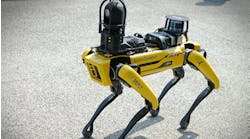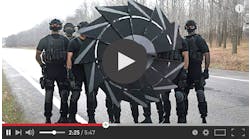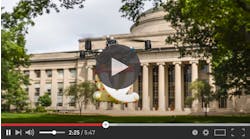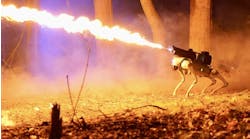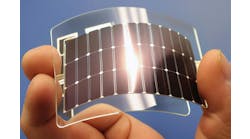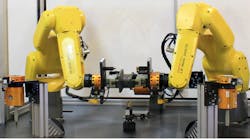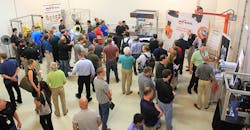Robots aren't taking over. They're becoming part of the workforce.
Advancements in robotics are helping manufacturers address the labor shortage by performing manual jobs more efficiently. In many cases, these robots are working in tandem with humans to complete various tasks.
Collaborative industrial robots, or "co-bots," typically come with motion and force-detecting sensors that make them safer for these systems to collaborate alongside people, according to a report released on June 5 by Loup Ventures, a venture capital firm that specializes in robotics and artificial intelligence.
In addition, co-bots are becoming more accessible to a wider range of manufacturers as the price declines, according to the report. In fact, total co-bot units shipped will increase from 8,950 in 2016 to 434,404 by 2025, Loup Ventures reported.
Manufacturers attending ATI Industrial Automation's annual technology fair on Aug. 10 will have an opportunity to learn about how they can benefit from the latest innovations in robotics.
The one-day event will include educational seminars and live robotic demonstrations of ATI's tool changers, multi-axis force/torque sensors, robotic collision sensors, and robotic deburring tools.
ATI expects approximately 300 attendees at this year's event, which will be co-located with Applied Manufacturing Technology's annual conference in Orion, Mich., says Robert Little, CEO of ATI Industrial Automation.
New Equipment Digest recently spoke with Little to discuss trends in robotics and find out what attendees can expect from this year's event.
NED: What are some of the key takeaways you expect from this event?
RL: One key focus area is the future of robots in sensing. Robots in the future must have force sensors to feel their environment, make decisions, and then act on them. With that in mind, we'll be talking about enhancements in our force torque sensor product line.
Robots typically have vision systems that allow them to see their environment and make decisions based on vision, but with touch and feel, they can perform many other tasks. For example, when you assemble by hand, you're feeling the part go in. A robot can do the same thing if it has a force sensor.
NED: What advancements have you made to improve the sensing capabilities of robots?
RL: One is the development of a special safety sensor that has extra precautions built in to ensure the force and torque feedback is accurate. That's important because if people are nearby, you want the robot to act on accurate information from force sensing to avoid accidents.
We've included dual-redundancy into the force torque sensor so it has more than one way to calculate the force. The two calculations must match within a certain percentage for the robot to know that the information is accurate, so it can make decisions safely.
Co-located with Applied Manufacturing Technology's annual conference in Orion, Mich., the ATI Industrial Automation's annual technology fair will deliver educational seminars and live robotic demonstrations designed to provide attendees with the critical information they need to harness the latest innovations in robotics.
NED: What type of industrial applications are ideal for force torque sensors?
RL: A lot of collaborative robots as well as standard robots are being used more frequently for assembly applications.
Electronics assembly is becoming very popular for robots, which includes inserting chips onto circuit boards.
In the collaborative world, such as automotive, we might be talking about installing a dashboard in a car. In these situations, people are working with the robot directly to help install the dashboard. The robot is doing the heavy lifting, but the people are helping with the orientation as well as maybe putting in certain fasteners at the right time as the robot does its tasks.
Robots also conduct testing. For example, when a car comes down the line, robots can push buttons or turn knobs in the car. All of the force and torque feedback is used to ensure quality. The key here is that the robot needs that sense of touch and feedback to make these decisions.
NED: Are there any industry trends that are leading to advancements in robotic sensing technologies?
RL: The cost of labor is going up, and it's becoming more difficult to find skilled labor. To maintain and improve our manufacturing base in the U.S., we have to advance automation. This driver is becoming more critical as we have reached full employment. If you want to open a manufacturing facility, you'll have a difficult time finding the manpower you need.
So in this day and age, if we don't have advancements in robotic technology we will start crippling the economy.
In the meantime, we have intense global competition in manufacturing. For example, even China has seen the writing on the wall and has opened more than 80 robot companies to advance automation technology. The robotics industry has realized double-digit growth since 2009.
In order for the robot industry to advance, we must focus on improving robot's ease of use and developing innovative end-effectors. Increasing flexibility while decreasing cost will make robotic automation accessible to a larger market.
NED: You have several speakers scheduled for the event. Can you provide a little more detail about what they will discuss?
RL: We're bringing in speakers from outside companies who have knowledge of robotic applications. One area that will receive a lot of attention at our tech fair is the robotic material removal applications, such as deburring, buffing, polishing and grinding. We'll have speakers who will offer their expertise in material removal, including a speaker from Acme Manufacturing, which is a robotic integrator. Another speaker that does quite a bit of automated material removal is Methods Machine Tools. A third company that will talk about their experience with integrating robotic material removal is iA-ROBOTICS.
My hope is that attendees will walk away with ideas to try at their own manufacturing facility, and that happens every year. We do a survey every year after the show, and customers overwhelmingly say they've walked away with new ideas for using robotic technologies in their own operations.
Find more information on ATI's August 10th Technology Fair here.
